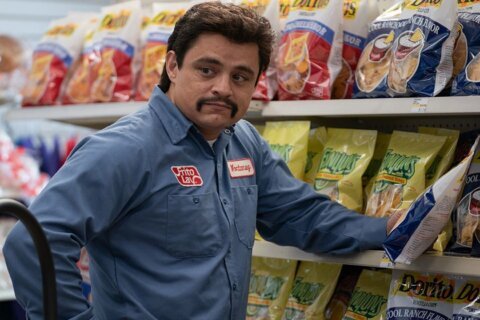WASHINGTON — Two TV stars hit the silver screen this week.
Jason Bateman (Netflix’s “Arrested Development”) directs and stars in the raunchy new comedy “Bad Words,” while Aaron Paul (AMC’s “Breaking Bad”) stars in the new action racing flick “Need for Speed.”
One is pretty bad, while the other is quite good. So which TV-to-film transition works out better?
We have in-depth reviews below, but first, check out our new Video Review:
![]()
‘Need for Speed’
The specter of “Breaking Bad” looms large over the entire movie-going experience of “Need for Speed,” with opening trailers that reference Heisenberg in Seth Rogen’s new comedy “Neighbors” (2014) and Bryan Cranston appearing in the new ad for “Godzilla” (2014).
When the film finally hits, the opening title cards remind us of two key points: that “Need for Speed” borrows its brand from the most successful video game franchise ever — 140 million copies by Electronic Arts — and takes its title from the top grossing movie of 1986 — “Top Gun.”
The plot casts our beloved Jesse Pinkman as Tobey Marshall, a former race car driver who works in an upstate New York auto-body garage by day and makes extra money by street racing at night. One day, Tobey’s rival, Dino Brewster (Dominic Cooper), challenges Tobey and his fellow mechanics to restore a Shelby Mustang that racing legend Carroll Shelby was working on before his death. The group is up to the task and shows off the sweet ride at an event where Tobey meets Julia Maddon (Imogen Poots), an exotic car dealer who’s far tougher than her high heels suggest.
After a tragic accident, Tobey embarks on a cross-country trip to seek revenge on Dino and clear his own name, evading both bounty hunters and police officers, and winning Julia’s heart in the process.
Audiences will buy in for the first 20 minutes, as the drive-in atmosphere of Mt. Kisco recalls the nostalgia of such great car flicks as “American Graffiti” (1973), “Two Lane Blacktop” (1971) and “Rebel Without a Cause” (1955). What’s more, the first few action sequences will wow audiences with the most thrilling racing since Ron Howard’s “Rush” (2013).
Unfortunately, the experience quickly “breaks bad” with a script that can’t keep up with the visuals. Director Scott Waugh had a similar problem in his military thriller “Act of Valor” (2012), where he displayed a creative eye for action but suffered from a sloppy screenplay. In “Need for Speed,” Waugh uses slow motion and the “vertigo effect,” where the image almost appears to detach from itself — an effect that will no doubt be enhanced if you see it in 3D. But the debut script by George Gatins, brother of “Flight” screenwriter John Gatins, is rife with problems on every level.
In great films, race or chase sequences serve as the occasional connecting tissue between the main thrust of the story. This one plays out the opposite way — the flimsy story is the occasional connecting tissue between the many excuses to have another racing sequence. Think back to the two most famous race/chase sequences in history: the chariot race in “Ben-Hur” (1959) and Popeye Doyle’s pursuit in “The French Connection” (1971). We remember these scenes so fondly because we were so invested in the characters by the time the action arrived on screen. When you fill your entire movie with these sequences, they start to blend together and lose their significance. Thus, “Need for Speed” feels way longer than it actually is. As the sleek cars repeatedly drift, so do our minds.
As the film wears on, you almost feel bad for all the talent involved, many of whom have done great work before, but now find themselves trapped in a ridiculous exercise.
Rapper Kid Cudi draws the job of being Tobey’s “eye in the sky,” flying a small plane over the streets as a lookout who insists on being called “Maverick” (one of many wannabe “Top Gun” moments). While we as viewers are willing to give the film a pass for this one unrealistic device, we lose all patience as Maverick shifts from a small plane to a TV news chopper and then, most ridiculously, an Apache helicopter that swoops in to save the day.
You’ll also feel bad for Rami Malek, who was great as the rookie counselor Nate in “Short Term 12” (2013). “Need for Speed” forces him to strip naked for no apparent reason, then has him dangle off the side of a truck to fill up another car’s gas tank — while both cars are in motion.
Michael Keaton does his best Wolfman Jack as the host of a racing radio show, but unlike Samuel L Jackson’s disc jockey in “Do the Right Thing” (1989), Keaton’s role feels far less organic. This is not Keaton’s fault; he tries like hell to sell us themes that aren’t fully realized in the script. His hyper monologues feel like sales pitches as to why we should like the movie: “Oh yeah, two star-crossed lovers, a tale of vengeance; I don’t know where this is going, but I love it!” Keaton may convince us that “racing is an art,” but we’re left rolling our eyes, saying, “So is subtle screenwriting.”
The script is so filled with on-the-nose dialogue and exposition (blatantly telling viewers what they need to know) that by the time Poots looks at Paul and says, “So that’s what this is really all about,” you’ll want to say, “Ya think?” I was even annoyed by the product placement — an “Act of Valor” DVD on a gas-station shelf — and a soundtrack filled with covers of “Fortunate Son,” “Back in the Saddle” and “All Along the Watchtower.” Everything feels packaged and phony, right down to the final “evidence” that’s used to incriminate the villain. There’s no way it would fly in court.
If there’s one silver lining, it’s that Aaron Paul proves he can play a leading man, even if he’s not a hulking force like Vin Diesel of “The Fast & The Furious” franchise. I just wish it were a better movie for him to carry. Even so, Paul has built up enough respect from his Emmy-winning turn on “Breaking Bad” that he’s allowed to make few missteps. Here’s hoping he rebounds as the Joshua to Christian Bale’s Moses in “Exodus” (2014) later this year.
★
The above rating is based on a 4-star scale. See where this film ranks in Jason’s 2013 Movie Guide. Follow WTOP Film Critic Jason Fraley on Twitter @JFrayWTOP, read his blog The Film Spectrum or listen Friday mornings on 103.5 FM.
![]()
‘Bad Words’
Ironically, of these two films, the better car-smashing scene comes in “Bad Words,” the directorial debut of Jason Bateman (“Arrested Development,” “Juno,” “Horrible Bosses”).
He plays Guy Trilby, a bitter word savant who selfishly enters a children’s spelling bee as an adult. This infuriates not only the parents of the child competitors, but also the spelling bee president (Allison Janney, “The Way Way Back”) and television announcer (Philip Baker Hall, Bookman from “Seinfeld”). On the flip side, the bizarre entry is intriguing to online journalist Jenny Widgeon (Kathryn Hahn), who is willing to pay him (financially and sexually) in the hopes of landing the inside scoop.
The “Billy Madison” premise could have easily become gimmicky, but Bateman offers a surprising amount of heart, as Guy befriends a young prodigy named Chaitanya Chopra (the adorable Rohan Chand) in a buddy team that might as well be called “Butch Dictionary and the Spell-dance Kid.”
The humor of “Bad Words” is not unlike that of “Big Daddy,” “Bad Santa” or “Bad Grandpa,” as the script mines laughs from the adult corruption of a young innocent. If you’re not in the market for R-rated humor, you might want to take the kids to “Muppets Most Wanted” this week. But if you’re craving raunchy humor, “Bad Words” offers hilarious pranks, from literal potty humor to moments of coming-of-age sexual awakening that will have you laughing, “That’s just wrong.”
Who knew that such funny lowbrow comedy could come from such a highbrow setting of definitions and word origins?
Still, “Bad Words” is much more than superficial crudeness. Just when the premise begins to drag with raunchy repetition about two-thirds of the way through the movie, the film pours it on down the stretch with clever twists and touching back stories revealing character motivations.
Perhaps the best part of “Bad Words” is seeing that Bateman can actually direct, using “mise-en-scene” (symbolic placement of all elements in the frame) to show his main character’s growth. When Guy first meets the young Indian boy Chaitanya, he threatens to tell the pilot that the boy is a terrorist about to hijack the plane. Later in an alley, Guy calls the young boy “Slumdog.” Superficial viewers might walk away feeling that Bateman’s character is a racist jerk, but if you look deeper, you’ll notice that Bateman is up to much more, from a giant sign with President Obama’s “CHANGE” logo in the background, to a cartoon stereotype on the hotel TV set during shots of Guy.
Above all, Bateman’s best directorial touch is the symbolic use of a toy police car to signify the lost innocence of childhood. While it’s no “Citizen Kane” sled, it does become an effective familiar image that it ultimately allows Guy and Chaitanya to bond despite their age difference.
And so every movie critic who watches “Bad Words” should put themselves on the spelling bee stage:
HOST: Your word: “CRITIC.”
ME: Can I have the origin, please?
HOST: A noun from the Latin ‘criticus’ and the Greek ‘kritik








